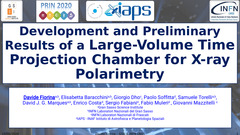Development and Preliminary Results of a Large-Volume Time Projection Chamber for X-ray Polarimetry
Davide Fiorina, on behalf of the HypeX collaboration
We present the development and initial results of a large-volume, increased field-of-view Time Projection Chamber (TPC) designed for X-ray polarimetry. This instrument utilizes a triple-GEM detector with optical readout, combining a scientific CMOS (sCMOS) camera to detect secondary scintillation light produced in the TPC amplification stage. Originally optimized for directional Dark Matter searches, this system has been adapted for X-ray polarimetry.
X-ray polarimetry offers a new window into the high-energy universe, providing critical insights into the magnetic fields, geometries, and emission mechanisms of cosmic sources such as black holes, neutron stars, and supernova remnants. Unlike traditional X-ray observations, which focus on intensity and energy, polarimetry adds the dimension of polarization, enhancing our understanding of these extreme and energetic phenomena.
The prototype TPC, with a cylindrical active volume of radius of 3.7 cm and height of 5 cm, was tested at the INAF-IAPS calibration facility in Rome, Tor Vergata. The aim was to assess the instrument's sensitivity to low-energy X-ray polarization and optimize parameters such as gas mixtures, amplification structures, and detector geometry. Testing showed complete reconstruction of photoelectrons in the 10-60 keV range with angular resolutions down to 15° and energy resolutions between 10-15% for the 5-45 keV range.
Data analysis involved measuring, reconstructing, and simulating electron tracks from a collimated 90Sr source. Angular resolution for electrons was better than 30° for energies above 10 keV and better than 20° for energies between 20 keV and 60 keV. The estimated modulation factor was greater than 0.6 for X-rays above 10 keV and greater than 0.8 for X-rays between 20 keV and 60 keV.
This TPC design extends X-ray polarimetry sensitivity to higher energies and enables observation of rapid transient phenomena like Gamma Ray Bursts (GRBs) and solar flares. Future improvements will explore different gas mixtures to enhance the photoelectric cross-section, with planned tests using fully polarized beams at the INAF calibration facility.




Comment submit